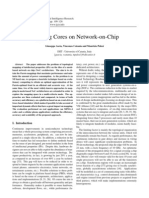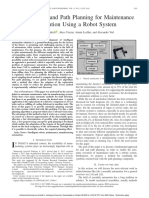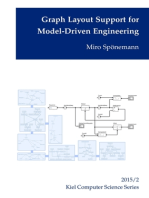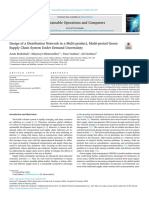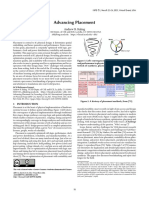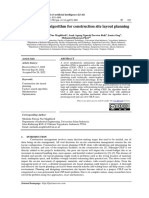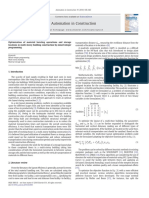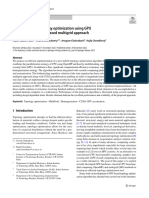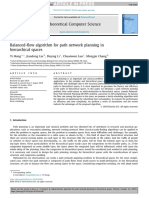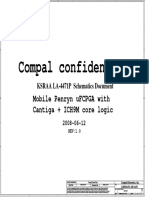Physical Aware Synthesis and Floorplan Challenges
Physical Aware Synthesis and Floorplan Challenges
Uploaded by
Ramya ScCopyright:
Available Formats
Physical Aware Synthesis and Floorplan Challenges
Physical Aware Synthesis and Floorplan Challenges
Uploaded by
Ramya ScCopyright
Available Formats
Share this document
Did you find this document useful?
Is this content inappropriate?
Copyright:
Available Formats
Physical Aware Synthesis and Floorplan Challenges
Physical Aware Synthesis and Floorplan Challenges
Uploaded by
Ramya ScCopyright:
Available Formats
International Journal of Hybrid Information Technology
Vol.9, No.1 (2016), pp. 279-290
http://dx.doi.org/10.14257/ijhit.2016.9.1.24
A Study of Floorplanning Challenges and Analysis of macro
placement approaches in Physical Aware Synthesis
Shivani Garg1 and Neeraj Kr. Shukla2
1, 2
VLSI Design Group, Department of EECE, ITM University, Gurgaon
(Haryana) India
Abstract
The macro placement is a governing factor in design flow in terms of timing criticality
and congestion metrics. Also tape-out schedules are affected because of quality of macro
placement or floorplanning. As hierarchical approach is followed for design closure
today, there are multiple macro iterations back and forth between synthesis and
implementation tool until the design meet all timing and design constraints. Traditional
flow takes much time to figure out the best floorplan in terms of timing, Quality of results
(QoR) and congestion. Now, physical aware synthesis gives a user an opportunity to cut
the implementation time at later stages. The approach used here is RTL level
floorplanning to enhance the quality of floorplan and also save multiple iterations. In one
shot we get automatic floorplan initially generated by tool and then used by Place and
Route (P&R) team for further processing. Also a rough estimate of wire delays and routes
to calculate parasitic value, hence delays is obtained. There are multiple ways of placing
macros in a floorplan which varies with shape of die and core utilization of design. So
when multi macro placement approaches are applied simultaneously, then one can
choose the best floorplan in terms of QoR and design metrics and then take it to
implementation tool. After studying floorplan and macro placement challenges, there is a
need to reduce cycle time between synthesis and implementation tool. In this work,
different macro placement approaches are applied on design for different shapes of die
(rectangular and rectilinear) using various parameters and then analyzed the timing,
design metrics and congestion of various approaches. The results obtained show that
every macro placement approach has different effect for different types of die on timing,
congestion and power. Thus we can easily automate floorplanning for different shapes of
die and reduce cycle time from months to few weeks. As checked on a design with 500k
instances and 18 macros, with utilization of 59% if rectangular die is chosen the
approach 3rd gives best result in congestion of 0.1% and the cycle time reduced from
weeks to days.
Keywords: congestion, die, floorplanning, macro placement, QoR
1. Introduction
As the interconnect delay dominates chip performance due to scaling of VLSI
Technology. It is not necessary that if a design is meeting timing after logic synthesis then
it will meet same after place and route because interconnect delays come into picture then.
Physical synthesis is an important feature of modern VLSI methods. Physical synthesis
begins with a mapped netlist generated by logic synthesis. The netlist generated after
logical synthesis describes the logical connections of the components such as macros,
input output blocks and pins. Physical synthesis generates a netlist which is optimized and
a physical layout which provides a basic estimation of placement and routing in
implementation tool.
ISSN: 1738-9968 IJHIT
Copyright ⓒ 2016 SERSC
International Journal of Hybrid Information Technology
Vol.9, No.1 (2016)
Physical aware synthesis is generation of a floorplan by P&R ( Place and Route) tool
and feeding back of floorplan DEF to synthesis tool and hence physical layout estimation
is used instead of wireload modelling estimation. The time taken in number of iterations
from synthesis to P&R and vice-versa reduces and timing improves resulting in a better
QoR. The Floorplanning step mainly includes macro placement, partitioning of design,
input-output ports placement and power planning. The design parameters such as power,
area, timing and performance need to be considered during floorplanning. These
estimations are calculated at every step based on the feedback from the implementation
team, IP owners, and RTL designers. In case of hierarchical designs, the number of
iteration increase as all the blocks are joined at top level at a later stage. A floorplan is a
proper arrangement of macros, blocks, power grid (rings or stripes) and input-output
ports. Figure 1.1 shows an example of floorplan.
Figure 1.1. A Floorplan View
The paper is organized in six sections. The section II provides the literature review of
the related work. In section III & IV floorplanning and macro placement challenges are
discussed respectively. The analysis and results are shown in section V. The section VI
provides conclusion and future scope.
2. Literature Review
An estimation model and a congestion aware floorplan have been discussed in [3], for
3D ICs. This model is based on analysis after considering Through Silicon Vias (TSV)
location and the congestion aware floorplan uses multiple approaches to evaluate results.
The approach discussed in [4] helps designers identify congestion related issues. This
approach allows macro placement, to analyze and compare congestion. The paper [5]
discussed challenges like: Automatic generation of data-path layout, More integrated
timing and power optimizations, Layout-friendly high-level synthesis Lithography-aware
physical synthesis and Quantifying the impact. A technique which improves the
placement solution for routing has been discussed here. This technique achieves the
placement and routing co-optimization to handle variation, contamination, and defect [1].
Placement algorithms optimize signal-net switching power. They ignore clock-network
switching, responsible for more than 30% of total power. New techniques and a
methodology to optimize total dynamic power during placement have been discussed for
large IC designs [16]. During floorplanning, two approaches have been discussed to
allocate level shifter regions which reduce time complexity [14]. The work discusses a
unified method to handle alignment and cluster constraints on sequence pair
representation which significantly reduces the solution space and speeds up the algorithm
[15].
A new floorplan representation [17], the circular-packing trees which can resolve the
problem of macro placement has been discussed here. This floorplan representation can
280 Copyright ⓒ 2016 SERSC
International Journal of Hybrid Information Technolog
Vol.9, No.1 (2016)
pack movable macros toward corners or preplaced macros along chip boundaries
circularly. This in turn optimizes macro orientations for better wirelength and routing
congestion. This work used design space exploration of low-power adders for
comparative analysis of Physical layout Aware Synthesis and Place and Route estimation
flow [18]. In [19], to handle large scale mixed size placement an effective algorithm is
discussed. Four steps for the flow are discussed which includes clustering of objects into
blocks , floor planning on blocks , optimizing wire length to shift the blocks within the
chip and placing the remaining objects incrementally keeping the big macro location as
fixed.
Floorplanning [21] techniques handle macros effectively but sometimes do not scale to
hundreds of thousands of placeable objects. In this floorplanning techniques are combined
with placement techniques in a design flow that solves the placement problem. The
techniques can also be used to guide circuit designers who prefer manual macro
placement. The discussed flow used an arbitrary black-box standard cell placer to get an
initial placement and then removes overlaps using a floorplanner at initial stage. The
wirelength improvements of 10%-50% have been observed. In [23], in order to reduce the
dynamic power a new design flow was presented for gated clock tree synthesis. An
approach is presented for the optimum power saving during shut off mode and full
operation mode on clock tree.
In [24], two well-known forces directed algorithm namely KK and FR is developed to
present a module placement tool. Feasibility of combining these two algorithms into one
placement tool is explored. Compared to that of current academic placement tool
remarkable results were observed [24]. In order to perform the multiple optimizations on
large design partitions an integrated transformation system is developed. A combination
of cloning and register placement and physically-aware register retiming is used [25]. For
analytical mixed-size placement in order to handle macro orientation a new rotation force
is presented. During placement a cross potential model is also discussed to increase the
rotation freedom [26].
In [27], to shorten the wire delay for dynamically reconfigurable processor, two
iterative synthesis techniques are presented in between the place and route tool and a high
level synthesizer (HLS). In the conclusion the wire delay has shortened the increased
synthesis time with only a slight increase of delay [27]. In [28] techniques to solve the
challenges from large-scale mixed sized designs of the circuits with wire length
optimization are used. For the modern circuit designs various challenges and
opportunities on routability and macro placement, timing, power and thermal- driven
optimization of placement are induced for future research. In this paper automated floor
planning methods are addressed which is essential for the efficient design space
exploration. A few techniques that can improve the existing tools for early floor planning
are also stated [29]. An approach for the floorplanning of rectangular blocks with various
constraints on their connection and dimension is used such that the total wire length and
area of the resulting floorplan are minimized [30].
A flexible and robust mixed size legalization scheme has been introduced to remove
the overlap between standard cells which also preserves the legalization of macros. To
reduce wirelength, a technique called as Sliding-window based cell swapping is applied in
the end [34]. An efficient algorithm which works on a novel augmented constraint graph
to remove overlap in the presence of fixed location, spacing and boundary constraints that
are predefined or imposed on macro cells earlier has been presented in [35]. One of the
operand isolation schemes is adopted to reduce switching in datapath which was causing
overhead in terms of delay, power, and area. Isolation techniques which are based on
supply gating reducing the overheads associated with isolating circuitry are presented
[37]. In [38] Rent’s rule has been used for estimation of interconnect power consumption.
Accordingly, the interconnect power reduction is 72.9% and overall power reduction is
56.0% with 44.4% area overhead as compared to area optimized circuits.
Copyright ⓒ 2016 SERSC 281
International Journal of Hybrid Information Technology
Vol.9, No.1 (2016)
A macro-cell placement algorithm uses a model for accurate delay analysis by
handling path-delay constraints. The algorithm is flexible in physical design flow since it
is iterative and incremental and gives better results in terms of path delay [39]. In [40] a
complete chip design method is presented which incorporates a soft-macro placement and
resynthesis method for area and timing improvements [40]. Three technologies which
governs logic synthesis and physical layout optimization including early floorplanning,
layout-driven logic synthesis, and post- layout resynthesis are discussed in [41].
3. Floorplanning Challenges
Many industries are moving towards lower technology nodes due to increase in
demand for SOC speed and performance. The floorplanning affects the design cycle
time in entire design flow from design planning to implementation. [6]. Some
challenges such as large design sizes, increasing macro count, timing/power
estimations, region shaping and pin assignment, predefined placement locations,
macro orientations and pin positions , simultaneous standard cell and macro
placement, congestion and timing-driven placement, reducing cycle time, high
performance and low power targets are increasing for a floorplan designer.
Sometimes, the macros need to be legalized to the periphery of the design in order
to provide maximum area for the standard cell placement. In some designs the
requirement is such that the macros need to be arrayed so that the address and data
lines have optimum distance to the logic which is connected to it. This is a manual
and iterative process between synthesis and implementation which has a large
impact on cycle time in designs [7].
As the design approach is now shifting towards hierarchical closure which
depends on the architectural requirements, tool limitations due to higher gate counts,
late IP deliverables, and different power modes in an SOC. The hierarchically
partitioned blocks are first implemented in terms of placement, routing, timing, and
noise closure .Then they are merged together into top level at later stage which
causes back and forth iterations between synthesis and implementation to optimize
floorplan. Sometimes there are cases of many top-level nets detouring across the
boundary of these partitions which on a later stage results in timing violations,
wasted routing resources due to large wirelength of nets and buffer i nsertion to
avoid design-rule violations on these nets. Ultimately, results in increased power
consumption and increased placement density [6].Some of the common issues [10,
11] which arise for physical design teams are:
3.1. IO Pad Placement
Sometimes we don’t have proper predefined input output constraints from the
packaging teams which can result in suboptimal order and location of input output
pads. This causes a problem for chip level timing closure. When detailed placement
and routing is complete, then designers have to iterate back and forth to fix IO pad
locations and again perform placement and routing. The unpredictable design
schedules causes risk of project delivery in time.
3.2. Macro Placement
Achieving optimal macro placement is a challenge for SoCs with large number of
cores and memories. Earlier macro placement was more of manual because the
number of macros was very less. But now there is a need of automated floorplan by
a tool before manual refinement by designer. Tools use to cluster macros based on
wire length but there are other metrics to be considered including critical path
timing, multi voltage power domains and reducing congestion. The challenge lies in
282 Copyright ⓒ 2016 SERSC
International Journal of Hybrid Information Technolog
Vol.9, No.1 (2016)
the fact that designers need better seed placement and a powerful macro placeme nt
editing that can assist in spacing and alignment of macros.
3.3. Region Shaping and Pin Assignment
Once the regions are determined, the regions or partition pins are assigned. The
challenge is to create pin placements that suits all design criteria but out of all, the
timing requirements between blocks for all analysis modes and corners are critical.
Pin assignments are based on wire length mainly as determined by Steiner -based
estimations. Poor pin assignments can be an issue for inter -partition timing paths
which may lead to costly sign-offs between the block level and chip level at later
stage in the design cycle.
3.4. Timing and Power Estimations
One of the main objectives of floorplanning stage is to have accurate estimations
of timing, power, and area as quickly as possible. The timing analysis should
include as many corner cases as is feasible that does not mean it should be sign -off
accurate. The floorplanning timing estimations are needed for all the timing
scenarios which may be later needed at timing sign-off stage. To avoid timing
criticality, sometimes memories needs to be placed near the core area. This in turn
places the related logic near it reducing the wire buffering and slew and slack. It
also impacts congestion. Power estimations at floorplanning stage should have a
good correlation with more detailed analysis later in the flow. If there are inaccurate
power estimates, there can be errors which can cause difficulty in closure. Multiple
power meshes are there in multi-Vdd designs, so at floorplanning stage the power
domains must be created and connected properly.
3.5. Creation of stacks
When the design contains multiple memories, stacks need to be created.
Memories are of different aspect ratios and different pin densities which results in
complexity of stack creation. One of the challenges in stacking is that smaller
memories have pin counts similar to bigger ones. For better routing accessibility and
reducing congestion, smaller memories are kept closer to the core area.
4. Macro Placement Challenges
As we know, macro placement can be manual or automatic. Manual macro
placement is more efficient when there are few macros to be placed and logical
connectivity of all is known. Automatic macro placement is more needed if there is
not enough information for initial macro placement and/or the number of macros is
large. During the macro placement step, the slicing tree is used by the floorplan
algorithm for slicing floorplan and to define routing channels between the blocks.
This should ensure minimum area between blocks and the channel definition should
be properly done [12].
Macro placement depends on factors including fly lines, ports communications,
macro's are placed at boundaries, macro grouping (logical hierarchy), spacing
between macro's, macro alignment, notches avoiding, macro’s orientation,
placement and routing blockages [20]. As the number of logic gates and associated
hard macro instances increases manual macro placement becomes nearly impossible.
Therefore user needs design automation solutions to speed-up hard macro
placement. Some of the macro placement challenges are as follows:
Copyright ⓒ 2016 SERSC 283
International Journal of Hybrid Information Technology
Vol.9, No.1 (2016)
4.1. Increasing Macro Count
With shifting of technology towards lower nodes, there is an increase in number
of macros of varying aspect ratios to be packed into a smaller which makes it
difficult to pack them tightly without wasting silicon area. There is a big challenge
in identifying the optimal solution through whole place and route flow. Also, the
increase in design size, macro counts, and macro shapes leads to longer runtimes
and more design cycle time which needs to be controlled [7].
Some algorithms used for automatic macro placement considers that macros are
connected to each other by nets. In hierarchical flows, macros are grouped on the
basis of connectivity, clock generation logic or power domains. Also, floorplans are
partitioned into functional groups which put physical constraints on placement of
standard cells and macros. Poorly shaped regions and broken logical hierarchy may
contribute to delayed schedules and lack of optimization in terms of timing, power
and area.
4.2. Predefined Placement Locations
Sometimes there are predefined locations of input output ports provided by
packaging team like some hard macros must be placed next to specific IO cells.
Then the pins of these hard macros must align and be close to specific I/O cells to
allow wide-wire connections. Generally, macros are pre-placed in specific locations
within the core area, and then their placements are fixed so they cannot be mo ved by
automated placement algorithms [10]. However, this approach of pre -placing and
fixing hard macro locations produces placement blockages for the rest of the design
logic. Thus a rectilinear area is available now for placing standard cells and
placement algorithms need to be capable of handling rectilinear placement areas.
4.3. Macro orientations and pin positions
In many placement algorithms, standard cells usually are assumed to be all the
pins at the center because macros are very large in size as compared to standard
cells. The length of a net between cells is simply the Manhattan distance between
their centroid. So now optimization of total wire length becomes a problem in
respect to distance calculation. If the pins are at different positions from center, then
macro orientations play a significant role. Depending on the orientation of the
macro, the lengths of the nets connecting to the macros can be different which
further complicates the optimization formulation.
4.4. Standard Cell and Macro Placement Simultaneously
Earlier, macro placement was done in two stages: manual placement of macros
pushing to edge of block/chip and fixing of the macro locations, then followed by
placement of the standard cells which assume the fixed macros to be placement and
routing blockages for standard cells. But during wire length optimization, both
macros and standard cells are not considered simultaneously. The pushing of macros
to edges may result in long routes. Therefore the timing results are sub -optimal.
4.5. Timing and congestion issues due to macros
The congestion due to hard macros is because it acts as placement and routing
blockage since it blocks first three to four layers of routing. Also the hard macro
pins needs a specific number of tracks causing congestion. Automatic estimation of
required tracks is needed to improve congestion. Reduction in total wire length and
the length of critical nets is needed to improve timing. Timing estimation should
consider detouring of routes which takes place because of macros.
284 Copyright ⓒ 2016 SERSC
International Journal of Hybrid Information Technolog
Vol.9, No.1 (2016)
4.6. Wide variety of sizes and shapes
Placing macros of varying sizes and aspect ratios without good optimization
engines can result in division of placement and routing space causing design to be
unroutable. When there are narrow columns between macros or closed space then it
may cause difficulty in routing.
4.7. Reduce Cycle Time
Key to meeting design schedule requirements is the ability to produce results quickly.
The large numbers of hard macros are not optimized consistently in every iteration
manually which results in long cycle time to obtain optimal configuration or floorplan.
5. Analysis and Results
After studying floorplan and macro placement challenges, there is a need to reduce
cycle time between synthesis and implementation tool. There are multiple kind of
approaches for macro placement considering factors such as macro legalization, macro
grouping, avoiding notch, macro alignment, refining partitions, distance between two
macros, halos around macros, orientation of macros and placement/routing blockages.
The objectives and sub objectives of work are:
1. To apply different macro placement approaches on design for different shapes of die
(rectangular and rectilinear) using various parameters.
2. Analyze the timing, design metrics and congestion of various approaches.
A data flow driven floorplan directly from RTL that concurrently optimizes for timing,
power, area and physical constraints is feed forward as initial guidance to place & route
teams. The Figures 2 & 3 shows the general synthesis and floorplan flow and
Implemented flow respectively.
Synthesis Floorplann Floorplann
ing Floorplann Synthesis ing
(Generate Synthesis
(creates ing (refine (further (productio
netlist (optimize)
initial floorplan) optimize) n
from RTL) floorplan)) floorplan)
Figure 3. General Synthesis and Floorplan Flow
RTL and Synthesis P&R (Refine & finish Iterations
(Generate dataflow production saved
driven floorplan ) floorplan)
Figure 4. Implemented Flow
Copyright ⓒ 2016 SERSC 285
International Journal of Hybrid Information Technology
Vol.9, No.1 (2016)
A sample design is chosen to perform analysis of different macro placement
approaches. Four types of die shapes are used to observe the behavior of multiple
approaches. There are ten kinds of macro placement approaches based on factors
including fly lines, ports communications, macro's are placed at boundaries, macro
grouping (logical hierarchy), spacing between macro's, macro alignment, notches
avoiding, macro’s orientation, placement and routing blockages. Below is the
analysis of QoR and design metrics for all approaches. The designer can pick
whatever feels best floorplan and take it to implementation tool. This will reduce
number of iterartions back and forth between synthesis and implementation tool.
5.1. Rectangular die
A rectangular die is used in this case with utilization 59% approximately The
Table 1 shows the comparison of congestion, timing QoR and power varying with
each kind of macro placement. The graphs ( Fig 5 ) shows congestion, WNS, TNS
and Total Power consumption variations w.r.t various macro placement approaches.
Table 1. Comparison of QoR for Multi-Approach Macro Placement for
Rectangular Die
Macro Congestion Worst Total Total Power (
Placement (% overflow) Negative Negative uW)
Approach Slack (ps) Slack (ps)
0 0.289403 -186.2 -191848 46373.97
1 0.144116 -190.8 -193402 47689.4
2 0.411825 -176.7 -201532 48675.66
3 0.916702 -183.5 -202467 48775.18
4 0.390684 -176.3 -189146 48107.69
5 0.370876 -175.9 -186557 49249.63
6 0.35868 -189.8 -200442 47895.5
7 0.390684 -176.3 -189146 48107.69
8 0.390684 -176.3 -189146 48107.68
9 0.390684 -176.3 -189146 48107.69
Worst Slack (pS) Congestion (%)
-165 1
0 1 2 3 4 5 6 7 8 9
-170 0.8
-175 0.6
-180 0.4
-185 0.2
-190
0
-195 0 1 2 3 4 5 6 7 8 9
(a) (b)
286 Copyright ⓒ 2016 SERSC
International Journal of Hybrid Information Technolog
Vol.9, No.1 (2016)
Total Negative Total Power ( µW)
Slack (pS) 0
50000
949000 1
48000
47000
-160000 8 46000 2
-180000 0 1 2 3 4 5 45000
6 7 8 9 44000
-200000
7 3
-220000
6 4
5
(c) (d)
Figure 5. Variations with Respect to Various Macro Placement
Approaches (a) Congestion (b) WNS (c) TNS (d) Total Power
Consumption
5.2. Rectilinear Die (L-Shape)
The Table 2 shows the comparison of congestion, timing QoR and power varying with
each kind of macro placement. The graphs ( Fig 6 ) shows congestion, WNS, TNS and
Total Power consumption variations w.r.t various macro placement approaches.
Table 2. Comparison of QoR for Multi-Approach Macro Placement for
Rectilinear die-L
Macro Placement Congestion (% Worst Total Negative Total Power (
Approach overflow) Negative Slack Slack (ps) uW)
(ps)
0 0.333775 -180.4 -181053 44003.23
1 0.609029 -188 -204321 53339.56
2 0.143939 -188.2 -195935 50009.36
3 0.341958 -182.5 -212123 51692.96
4 0.437779 -184.2 -209928 51572.3
5 1.35947 -229.1 -214538 51233.77
6 0.570334 -204.1 -219916 53753.56
7 0.437779 -184.2 -209928 51572.3
8 0.117789 -188.7 -192464 49233.25
9 0.188339 -182.5 -215152 52139.55
congestion (%) WNS ( pS)
1.5 0
0 1 2 3 4 5 6 7 8 9
-50
1
-100
0.5 -150
-200
0
0 1 2 3 4 5 6 7 8 9 -250
(a) (b)
Copyright ⓒ 2016 SERSC 287
International Journal of Hybrid Information Technology
Vol.9, No.1 (2016)
TNS (pS) Power (µW)
0
60000
0 9 1
0 1 2 3 4 5 40000
6 7 8 9
-200000 8 20000 2
0
-400000 7 3
6 4
5
(c) (d)
Figure 6. Variations with Respect to Various Macro Placement Approaches
(a) Congestion (b) WNS (c) TNS (d) Total Power Consumption
5.3. Rectilinear Die ( U-Shape)
In this case rectilinear die of U-shape is used with utilization of approximately 49%.
The Table 3 shows the comparison of congestion, timing QoR and power varying with
each kind of macro placement. The graphs (Figure 7) show congestion, WNS, TNS and
Total Power consumption variations w.r.t various macro placement approaches.
Table 4.3. Comparison of QoR for Multi-Approach Macro Placement for
Rectilinear Die-U
Macro Congestion (% Worst Total Negative Total Power (
Placement overflow) Negative Slack Slack (ps) uW)
Approach (ps)
0 0.355747 -180.8 -188551 48744.23
1 0.381626 -180.2 -189317 47574.58
2 0.312003 -175.5 -186816 47217.29
3 0.675045 -186.2 -195554 49908.05
4 0.128027 -184.2 -176272 50292.61
5 0.175622 -187.4 -176064 48732.78
6 0.19481 -181.6 -194216 47567.34
7 0.128027 -184.2 -176272 50292.61
8 0.128027 -184.2 -176272 50292.61
9 0.122105 -174.9 -182709 49493.41
congestion(%) WNS(ps)
0.8
-165
0 1 2 3 4 5 6 7 8 9
0.6 -170
0.4 -175
-180
0.2
-185
0
0 1 2 3 4 5 6 7 8 9 -190
(a) (b)
288 Copyright ⓒ 2016 SERSC
International Journal of Hybrid Information Technolog
Vol.9, No.1 (2016)
TNS(ps) Power(µW)
0
-160000 52000
9
50000 1
0 1 2 3 4 5
-180000 6 7 8 9 48000
846000 2
44000
-200000 7 3
6 4
5
(c) (d)
Figure 7. Variations with Respect to various macro placement
approaches (a) Congestion (b) WNS (c) TNS (d) Total Power
consumption
6. Conclusion
From previous discussions, results and analysis, it can be concluded that the macro
placement has a huge impact on timing and congestion in design flow. Also the
floorplanning is a very critical step in complete design implementation flow. A good or
bad floorplan may be a determining factor in tape-out schedules. When hierarchical
approach is followed for design closure, there are multiple macro iterations back and forth
between synthesis and implementation tool until the design meet all timing and design
constraints. RTL level floorplanning enhances the quality of floorplan and also saves
multiple iterations. In one shot we get automatic floorplan initially generated by tool and
then used by P&R team for further processing. So when multi macro placement
approaches are applied simultaneously, then one can choose the best floorplan in terms of
QoR and design metrics and then take it to implementation tool. The results show that
every macro placement approach has different effect for different types of die on timing,
congestion and power. Thus we can easily automate floorplanning for different shapes of
die and observe results. As checked on a design with 500k instances and 18 macros, with
utilization of 59% if rectangular die is chosen the approach 3rd gives best result in
congestion of 0.1% and the cycle time reduced from weeks to days.
References
[1] Chen Liao and Shiyan Hu, “Physical-Level Synthesis for Digital Lab-On-a-Chip Considering Variation,
Contamination and Defect,” IEEE Transactions on Nanobioscience, vol. 13, no. 1, pp. 3-11, March 2014
[2] Chia-Chun Lin, Susmita Sur-Kolay and Niraj K. Jha, “PAQCS: Physical Design-Aware Fault-Tolerant Quantum
Circuit Synthesis,” IEEE Transactions on Very Large scale Integration (VLSI) Systems, 2014.
[3] Wenrui Li , Jaehwan Kim and Jong-Wha Chong, “A Novel Congestion Estimation Model and Congestion Aware
Floorplan for 3D ICs”, in proc. of International Conference on Innovation, Management and Technology Research
(ICIMTR),IEEE ,pp. 199-204, 21-22 May, 2012
[4] Ankit Goyal, “Evaluating Macro Placement in an SoC Block Based on a Congestion Estimate,” in proc. of IEEE
Canadian Conference on Electrical and Computer Engineering (CCECE), 2012
[5] Igor L. Markov, Jin Hu and Myung-Chul Kim, “Progress and Challenges in VLSI Placement Research,” ACM, 2012.
[6] “Floorplanning: concept, challenges, and closure,” URL: http://www.edn.com/design/integrated-circuit-
design/4396580/Floorplan
[7] Arvind Narayanan and James Forsyth, “Automatic Macro Placement for Advanced Nodes,” Mentor Graphics.
[8] Golshan K., “Floorplanning,” Physical Design Essentials : An ASIC Design Implementation Perspective, pp 37-69,
2007.
[9] Mike Clarke, Diego Hammerschlag, Matt Rardon and Ankush Sood, “Eliminating Routing Congestion Issues with
Logic Synthesis,” Cadence Design Systems
[10] Ratan Devpura, Niraj Jani, Jignesh Panwala and Parth Lakhiya, “Physical Design Implementation Challenges in
Highly Memory-Intensive Design in 40nm,” Electronics for You, pp. 36-38, July 2013.
[11] “Advanced Floorplanning with Olympus-SOC for Fast and Reliable Design Closure,” www.mentor.com
[12] “Hard Macro Placement in Complex SoC Design,” URL: http://www.soccentral.com/
Copyright ⓒ 2016 SERSC 289
International Journal of Hybrid Information Technology
Vol.9, No.1 (2016)
[13] “Automatic Macro Placement for Olympus-SoC,” User’s Manual, Software Version 2013.1, Mentor Graphics, July
2013
[14] Jai-Ming Lin, Wei-Yi Cheng, Chung-Lin Lee, and Richard C.J. Hsu, “Voltage Island-Driven Floorplanning
Considering Level shifter Placement”,IEEE, pp.443-448, 2012
[15] Shantesh Pinge, Rajeev K Nain and Malgorzata Chrzanowska-Jeske, “Fast Floorplanning With Placement
Constraints”, IEEE, 2013
[16] Dong-Jin Lee and Igor L. Markov, “Obstacle-Aware Clock-Tree Shaping During Placement”, IEEE Transactions on
Computer-Aided Design of Integrated Circuits and Systems, vol. 31, no. 2, pp. 205-216, February 2012
[17] Yi-Fang Chen, Chau-Chin Huang, Chien-Hsiung Chiou, Yao-Wen Chang, and Chang-Jen Wang, “Routability-Driven
Blockage-Aware Macro Placement”
[18] Ivan Ratkovi, Oscar Palomar, Milan Stani, Osman Unsal, Adrian Cristal, Mateo Valero, “Physical vs. Physically-
Aware Estimation Flow: Case Study of Design Space Exploration of Adders”, in proc. of IEEE Computer Society
[19] Jackey Z. Yan, Natarajan Viswanathan, and Chris Chu, “Handling Complexities in Modern Large-Scale Mixed-Size
Placement”, pp.436-441
[20] “Macro Placement (Guide Lines),” http://vlsipd.blogspot.in/2013/06/macro-placement-guide-lines.html
[21] Saurabh N. Adya and Igor L. Markov, “Consistent Placement of MacroBlock Using Floorplanning and StandardCell
Placement”, ISPD’02, April 7-10,2002
[22] Sanjiv Taneja, “Physical-Aware, High-Capacity RTL Synthesis for Advanced Nanometer Designs,” Cadence Design
Systems, March 4-6, 2103.
[23] Teng Siong Kiong and Dr. Norhayati Soin, “Physical Aware Low Power Clock Gates Synthesis Algorithm for High
Speed VLSI Design”
[24] Meththa Samaranayake, Helen Ji and John Ainscough, “Module Placement Based on Hierarchical Force Directed
Approach”, in proc. of International Conference on Signals, Circuits and Systems, IEEE, pp. 1-6, 2009
[25] David A. Papa, Smita Krishnaswamy, and Igor L. Markov, “SPIRE: A Retiming-Based Physical-Synthesis
Transformation System”,IEEE, pp. 373-380,2010
[26] Meng-Kai Hsu and Yao-Wen Chang, “Unified Analytical Global Placement for Large-Scale Mixed-Size Circuit
Designs”,IEEE, pp. 657-662,2010
[27] Takao Toi , Takumi Okamoto, Toru Awashima, Kazutoshi Wakabayashi,and Hideharu Amano, “Wire Congestion
Aware Synthesis for a Dynamically Reconfigurable Processor”, IEEE, pp. 300-303, 2010
[28] B. Sekhara Babu, Rajine Swetha R, Dr. Sumithra Devi K. A., “Comparison of Hierarchial Mixed-Size Placement
Algorithms for VLSI Physical Synthesis”, in proc. of International Conference on Communication Systems and
Network Technologies,IEEE, pp. 430-435,2011
[29] Jeonghee Shin, John A. Darringer, Guojie Luo, Merav Aharoni, Alexey Y. Lvov, Gi-Joon Nam and Michael B.
Healy, “Floorplanning Challenges in Early Chip Planning”, IEEE, pp. 388-393, 2011
[30] Chang-Sheng Ying and Joshua Sook-Leung Wong, “An Analytical Approach to Floorplanning for Hierarchical
Building Blocks Layout” , IEEE Transactions on Computer-Aided Design, vol. 8, no. 4, April 1989
[31] RealTime User Guide (14.2), Mentor Garphics.
[32] URL: http://www.oasys-ds.com/products/realtime-designer
[33] URL:https://www.semiwiki.com/forum/content/2388-oasys-announces-floorplan compiler.html
[34] Jason Cong, and Min Xie, “A Robust Mixed-Size Legalization and Detailed Placement Algorithm,” IEEE
Transactions on Computer-Aided Design of Integrated Circuits and Systems, vol. 27, no. 8,pp. 1349-1362, August
2008
[35] Thenappan M, Senthil Arasu T, Sreekanth KM, Ramesh S Guzar, “An Overlap Removal Algorithm for Macrocell
Placement in VLSI Layouts,” in proc. of International Conference on Computing: Theory and Applications
(ICCTA'07), IEEE, 2007
[36] Sudeep Pasricha, Nikil D. Dutt, Elaheh Bozorgzadeh, and Mohamed Ben-Romdhane, “FABSYN: Floorplan-Aware
Bus Architecture Synthesis,” IEEE Transactions on Very Large Scale Integration (VLSI) Systems, vol. 14, no. 3,pp.
241-253, March 2006
[37] N. Banerjee, A. Raychowdhury, S. Bhunia, H. Mahmoodi, and K. Roy, “Novel Low-Overhead Operand Isolation
Techniques for Low-Power Datapath Synthesis,” in proc. of International Conference on Computer Design
(ICCD’05), IEEE, 2005
[38] Lin Zhon and Niraj K. Jha, “Interconnect-aware High-level Synthesis for Low Power,” IEEE, pp.110-117, 2002
[39] Fan MO, Abdallah Tabbara and Robert K. Brayton, “A Timing-driven Macro-cell Placement Algorithm”, IEEE,
pp.322-327, 2001
[40] Hsiao-Pin Su, Allen C.-H. Wu, and Youn-Long Lin, “A Timing-Driven Soft-Macro Placement and Resynthesis
Method in Interaction with Chip Floorplanning”, IEEE Transactions on Computer-Aided Design of Integrated
Circuits and Systems, vol. 18, no. 4, pp.475-483, April 1999
[41] Massoud Pedram, “Logical-Physical Co-design for Deep Submicron Circuits: Challenges and Solutions”, IEEE,
pp.137-142, 1998
[42] S.V. Venkatesh, “Hierarchical Timing driven Floorplanning and Place and Route Using a Timing Budgeter”, in proc.
of IEEE 1995 Custom Integrated Circuits Conference, pp.469-472, 1995
[43] URL: http://www.synopsys.com/Company/Publications/SynopsysInsight/Pages/Art2-synthesis-technology-IssQ4-
12.aspx
[44] URL: http://www.edn.com/design/integrated-circuit-design/4313674/Establishing-timing-correlation-between-tools
[45] Saxena P., “An Introduction To Routing Congestion,” Routing Congestion in VLSI Circuits Estimation and
Optimization, pp 3-29,
[46] M.J.S Smith, “Floorplanning and Placement,” Application Specific Integrated Circuits, 1997
290 Copyright ⓒ 2016 SERSC
You might also like
- First Quarter Mathematics Sample Final Examination For Grade 12Document6 pagesFirst Quarter Mathematics Sample Final Examination For Grade 12Khalid A.No ratings yet
- Fte Monitor LCDDocument85 pagesFte Monitor LCDcaragy100% (1)
- Lakes Wrplot View Release NotesDocument6 pagesLakes Wrplot View Release NotesOscar Adolfo Rios CastroNo ratings yet
- Query Profiler Versus Cache For Skyline Computation: R. D. Kulkarni B. F.MominDocument4 pagesQuery Profiler Versus Cache For Skyline Computation: R. D. Kulkarni B. F.MominRahul SharmaNo ratings yet
- Research Article: Fastroute: An Efficient and High-Quality Global RouterDocument19 pagesResearch Article: Fastroute: An Efficient and High-Quality Global RouterAditia GinantakaNo ratings yet
- A Unified Framework Integrating Decision Making and Trajectory Planning Based On Spatio-Temporal Voxels For Highway Autonomous DrivingDocument15 pagesA Unified Framework Integrating Decision Making and Trajectory Planning Based On Spatio-Temporal Voxels For Highway Autonomous Driving1450468400No ratings yet
- Mapping Cores On Network-on-Chip: ° Research India Publications HTTP://WWW - Ijcir.infoDocument18 pagesMapping Cores On Network-on-Chip: ° Research India Publications HTTP://WWW - Ijcir.infoHerdawati TiansinNo ratings yet
- Smooth Path Planning in Constrained Environments: Martin Rufli Dave Ferguson Roland SiegwartDocument6 pagesSmooth Path Planning in Constrained Environments: Martin Rufli Dave Ferguson Roland SiegwartTales MarquesNo ratings yet
- Efficient Task and Path Planning For Maintenance Automation Using A Robot SystemDocument11 pagesEfficient Task and Path Planning For Maintenance Automation Using A Robot SystemPeiman AzizidustNo ratings yet
- Search-Based Planning For Manipulation With Motion PrimitivesDocument7 pagesSearch-Based Planning For Manipulation With Motion PrimitivesTales MarquesNo ratings yet
- Shin y Yoon - 2023 - Performance Evaluation of Building Blocks of SpatiDocument18 pagesShin y Yoon - 2023 - Performance Evaluation of Building Blocks of Spatiorco sistemasNo ratings yet
- Actuators 10 00314 v3Document19 pagesActuators 10 00314 v3Ishwar NiraleNo ratings yet
- VT Gridce - PsDocument32 pagesVT Gridce - PsssfofoNo ratings yet
- A Review On Four Different Methods of FloorplanningDocument13 pagesA Review On Four Different Methods of FloorplanningSivaranjan GoswamiNo ratings yet
- Single-Step Deep Reinforcement Learning For Two-And Three-Dimensional Optimal Shape DesignDocument22 pagesSingle-Step Deep Reinforcement Learning For Two-And Three-Dimensional Optimal Shape DesignbuntarNo ratings yet
- OptmizationTechniques Survey 2016Document12 pagesOptmizationTechniques Survey 2016Viviane FalcãoNo ratings yet
- Site LayoutDocument16 pagesSite LayoutGary LoNo ratings yet
- Jurnal Ilmiah Widya Teknik: Redesign Facility Layout With Quantitative and Qualitative Method On Printing IndustryDocument5 pagesJurnal Ilmiah Widya Teknik: Redesign Facility Layout With Quantitative and Qualitative Method On Printing IndustryLazuardy Hasan PratamaNo ratings yet
- Framework DesignDocument20 pagesFramework DesignManea RaduNo ratings yet
- Reinforcement Learning For Architectural DesignDocument10 pagesReinforcement Learning For Architectural Designjoaopedro.bragaiaNo ratings yet
- Mi 150105Document8 pagesMi 150105古鹏飞No ratings yet
- Im Improving Memory Proving Space Utilization in Multi-Core Embedded Systems Using Task RecomputationDocument9 pagesIm Improving Memory Proving Space Utilization in Multi-Core Embedded Systems Using Task RecomputationijcsnNo ratings yet
- Multi Objective Task Scheduling Using Hybrid Whale GeneticDocument27 pagesMulti Objective Task Scheduling Using Hybrid Whale GeneticBhaskar BanerjeeNo ratings yet
- Li Li Et Al - Adaptive Application Composition in Quantum ChemistryDocument19 pagesLi Li Et Al - Adaptive Application Composition in Quantum ChemistryElectro_LiteNo ratings yet
- Two Dimensional Airfoil Optimisation Using CFD in A Grid Computing EnvironmentDocument8 pagesTwo Dimensional Airfoil Optimisation Using CFD in A Grid Computing Environmentananth9660No ratings yet
- Content ServerDocument22 pagesContent ServerIgnacius Garridum ContulianoNo ratings yet
- Performance Evaluation of Replication Policies in Microservice Based ArchitecturesDocument21 pagesPerformance Evaluation of Replication Policies in Microservice Based ArchitecturesngengszterNo ratings yet
- Path Planning For Robots An Elucidating DraftDocument14 pagesPath Planning For Robots An Elucidating DraftAnkur BhargavaNo ratings yet
- Road ConstructionDocument10 pagesRoad ConstructionNouman JilaniNo ratings yet
- Design of A Distribution Network in A Multi Product M - 2022 - Sustainable OperDocument12 pagesDesign of A Distribution Network in A Multi Product M - 2022 - Sustainable Operbinh.nguyen040814No ratings yet
- Loosely Coupled MethodDocument18 pagesLoosely Coupled MethodMadhu Kiran Reddy MuliNo ratings yet
- Transactions Letters: Efficient and Configurable Full-Search Block-Matching ProcessorsDocument8 pagesTransactions Letters: Efficient and Configurable Full-Search Block-Matching ProcessorsrovillareNo ratings yet
- Advancing Placement: Andrew B. KahngDocument8 pagesAdvancing Placement: Andrew B. Kahngஇரா.பவித்ர குருNo ratings yet
- Cuckoo Search Algorithm For Construction Site Layout PlanningDocument10 pagesCuckoo Search Algorithm For Construction Site Layout PlanningIAES IJAINo ratings yet
- Makespan Optimisation in Cloudlet Scheduling With ImprovedDocument11 pagesMakespan Optimisation in Cloudlet Scheduling With Improvedmoin latifNo ratings yet
- Optimization of Material Hoisting Operations and StorageDocument8 pagesOptimization of Material Hoisting Operations and StorageDarko TešićNo ratings yet
- Parallel Ray Tracing Using Mpi and Openmp: January 2008Document18 pagesParallel Ray Tracing Using Mpi and Openmp: January 2008Chandan SinghNo ratings yet
- Literature Review: 2.1 GeneralDocument11 pagesLiterature Review: 2.1 Generalnabajyoti deyNo ratings yet
- Systematic Inspection of Scheduling Policies and Algorithms in Grid ComputingDocument7 pagesSystematic Inspection of Scheduling Policies and Algorithms in Grid ComputingInternational Journal of Application or Innovation in Engineering & ManagementNo ratings yet
- Automation PDFDocument16 pagesAutomation PDFdahir_00No ratings yet
- Improved Task Scheduling Model With Task Grouping For Cost and Time OptimizationDocument5 pagesImproved Task Scheduling Model With Task Grouping For Cost and Time OptimizationAnurag JainNo ratings yet
- Aerospace: Application of An Efficient Gradient-Based Optimization Strategy For Aircraft Wing StructuresDocument27 pagesAerospace: Application of An Efficient Gradient-Based Optimization Strategy For Aircraft Wing StructuresMohsen ManounNo ratings yet
- Scheduling and Resource Allocation On Cloud Computing: SurveyDocument5 pagesScheduling and Resource Allocation On Cloud Computing: SurveyR M Shi NyNo ratings yet
- DEMAP: Differential Evolution Mapping For Network On Chip OptimizationDocument11 pagesDEMAP: Differential Evolution Mapping For Network On Chip OptimizationIAES International Journal of Robotics and AutomationNo ratings yet
- Clustering of Architectural Floor Plans - A Comparison of Shape RepresentationsDocument18 pagesClustering of Architectural Floor Plans - A Comparison of Shape RepresentationsanonimoNo ratings yet
- Estimation of Concrete Paving Construction Productivity Using Discrete Event SimulationDocument14 pagesEstimation of Concrete Paving Construction Productivity Using Discrete Event SimulationJames SarolNo ratings yet
- Efficient Hybrid Topology Optimization Using GPUDocument23 pagesEfficient Hybrid Topology Optimization Using GPUMd MehtabNo ratings yet
- Using Genetic Algorithms To Resolve Facility Layout ProblemDocument12 pagesUsing Genetic Algorithms To Resolve Facility Layout ProblemRiza Nindiana ValeryNo ratings yet
- GLARE: Global and Local Wiring Aware Routability EvaluationDocument6 pagesGLARE: Global and Local Wiring Aware Routability Evaluation黃昭惠No ratings yet
- OptmizationTechniques Survey 2016Document12 pagesOptmizationTechniques Survey 2016gabriela.sanmartin.narreaNo ratings yet
- 10.3934 Mbe.2022425Document21 pages10.3934 Mbe.2022425Nguyen Khac ChienNo ratings yet
- A Multi-Stream Feature Fusion Approach For Traffic Prediction.Document5 pagesA Multi-Stream Feature Fusion Approach For Traffic Prediction.saikrishnagandla119No ratings yet
- Path Planning For An Industrial Robotic ArmDocument7 pagesPath Planning For An Industrial Robotic ArmZahid IqbalNo ratings yet
- Informs: INFORMS Is Collaborating With JSTOR To Digitize, Preserve and Extend Access To Operations ResearchDocument19 pagesInforms: INFORMS Is Collaborating With JSTOR To Digitize, Preserve and Extend Access To Operations Researchadissa2103No ratings yet
- Race Logic: A Hardware Acceleration For Dynamic Programming AlgorithmsDocument12 pagesRace Logic: A Hardware Acceleration For Dynamic Programming AlgorithmsssfofoNo ratings yet
- Optimal Sizing of CMOS Analog Circuits Using Gravitational Search Algorithm With Particle Swarm OptimizationDocument23 pagesOptimal Sizing of CMOS Analog Circuits Using Gravitational Search Algorithm With Particle Swarm OptimizationmohsenparsauniNo ratings yet
- Automatic Path Planning of Industrial Robots Comparing Samp - 2017 - Procedia MaDocument8 pagesAutomatic Path Planning of Industrial Robots Comparing Samp - 2017 - Procedia Mawfy458nj92No ratings yet
- Applications of Matlab in Optimization of BridgeDocument6 pagesApplications of Matlab in Optimization of BridgeInternational Journal of Research in Engineering and TechnologyNo ratings yet
- Theoretical Computer Science: Yi Hong, Jiandong Liu, Deying Li, Chuanwen Luo, Mengjie ChangDocument11 pagesTheoretical Computer Science: Yi Hong, Jiandong Liu, Deying Li, Chuanwen Luo, Mengjie ChangDinda AisyNo ratings yet
- On Global Smooth Path Planning For Mobile Robots Using A Novel Multimodal Delayed PSO AlgorithmDocument14 pagesOn Global Smooth Path Planning For Mobile Robots Using A Novel Multimodal Delayed PSO Algorithmhind90No ratings yet
- Computational Geometry: Exploring Geometric Insights for Computer VisionFrom EverandComputational Geometry: Exploring Geometric Insights for Computer VisionNo ratings yet
- Ocjd PDFDocument141 pagesOcjd PDFBakó JuditNo ratings yet
- Compal LA-4471P r10Document47 pagesCompal LA-4471P r10duron9000No ratings yet
- Immediate Download Principles of Business Forecasting Keith Ord & Robert Fildes All ChaptersDocument34 pagesImmediate Download Principles of Business Forecasting Keith Ord & Robert Fildes All Chapterslatchdhola100% (2)
- Top 500 Keywords in The Last 365 DaysDocument15 pagesTop 500 Keywords in The Last 365 DaysFarhan Ali ZeeshanNo ratings yet
- Project Report FormatDocument3 pagesProject Report FormatIbraheem Abdulrasheed AyomideNo ratings yet
- Computer Applications (86) : Class IxDocument3 pagesComputer Applications (86) : Class IxVikas ChaurasiyaNo ratings yet
- Developer HTTP Testphp Vulnweb ComDocument188 pagesDeveloper HTTP Testphp Vulnweb ComMayur PawarNo ratings yet
- 3592 Operator GuideDocument103 pages3592 Operator GuideNaim GhattasNo ratings yet
- Tan Delta Cable TestingDocument6 pagesTan Delta Cable Testingdamlan1100% (2)
- An Overview of The GSM SystemDocument32 pagesAn Overview of The GSM System0796105632No ratings yet
- Future Indian Banking - Internet BankingDocument98 pagesFuture Indian Banking - Internet BankingRahul R RohitNo ratings yet
- Enroll PortalDocument21 pagesEnroll PortalNikhil JaiswalNo ratings yet
- Project Report On PN Diode Characterization (Using LTSpice)Document11 pagesProject Report On PN Diode Characterization (Using LTSpice)KnimiNo ratings yet
- Valenzo HDocument87 pagesValenzo HduongdhNo ratings yet
- SciPoultryAndMeatProcessing - Barbut - 13 Meat Processing - V01Document93 pagesSciPoultryAndMeatProcessing - Barbut - 13 Meat Processing - V01cmNo ratings yet
- CD54HC4094, CD74HC4094, CD74HCT4094: High Speed CMOS Logic 8 Stage Shift and Store Bus Register, Three StateDocument22 pagesCD54HC4094, CD74HC4094, CD74HCT4094: High Speed CMOS Logic 8 Stage Shift and Store Bus Register, Three Statealllim88No ratings yet
- Vplex Volume ResizeDocument4 pagesVplex Volume ResizeSrinivas KumarNo ratings yet
- What Is Quality:: Unit 1Document11 pagesWhat Is Quality:: Unit 1amirNo ratings yet
- Productivity Techniques SyllabusDocument3 pagesProductivity Techniques SyllabusAlberto FernandesNo ratings yet
- 2 Research PaperDocument4 pages2 Research PaperSyed IkramNo ratings yet
- MSIS4523 Ch1.Intro To DatacomDocument31 pagesMSIS4523 Ch1.Intro To DatacomAlicia Kay LearNo ratings yet
- HP w2007 w2007v SMDocument75 pagesHP w2007 w2007v SMfeliNo ratings yet
- Eds 3000Document6 pagesEds 3000AlphaNo ratings yet
- Three Dimensional Object RepresentationDocument46 pagesThree Dimensional Object Representationfelipecarvalho.bio8427No ratings yet
- eXact2-SpecSheet ENDocument5 pageseXact2-SpecSheet ENjaalcebNo ratings yet
- Multiplexing (DC)Document64 pagesMultiplexing (DC)akrNo ratings yet
- MIRA Guide - Pv2Document2 pagesMIRA Guide - Pv2stefaneduardNo ratings yet






